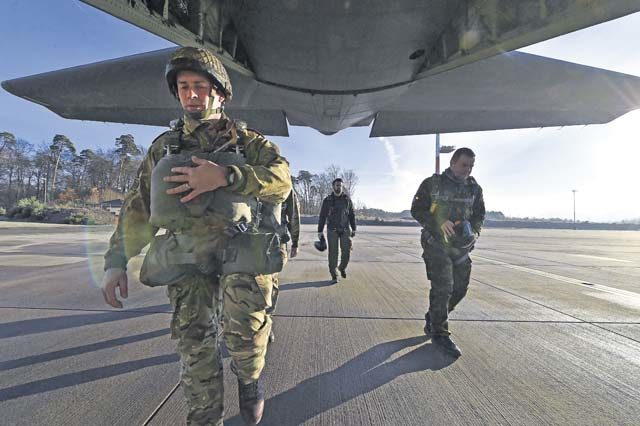
Clear skies and a cold breeze added to the atmosphere of the moment while two crews assigned to the 37th Airlift Squadron at Ramstein assisted their passengers’ mission for the day: jumping out of a perfectly good C-130J Super Hercules.
Nov. 28 through Dec. 2 marked the most recent iteration of International Jump Week, an exercise held biannually with NATO allies. On Nov. 30, two Hercules de-iced on the Ramstein flightline, picked up more than 100 paratroopers and flew them to their drop zone.
Part of the purpose of the exercise is to support the squadron’s operational mentality, said Senior Airman Patrick Cassidy, 37 AS loadmaster.
“The importance of a day like this is to demonstrate that we have the capability to go and be ready now,” Cassidy said. “Basically, if the call comes in, we can go anywhere in the world and deploy our troops.”
While practicing and demonstrating the capabilities of both the C-130J and the Airmen who operate and maintain the aircraft is a large piece to the puzzle, it isn’t the only piece by any stretch of the imagination.
The mission also served as a training opportunity for some of the crew. The co-pilot, Capt. Peter Wolber, is new to the ‘J’ model of the aircraft. This meant that the aircraft commander, Maj. Corey Preston, 37 AS assistant director of operations, had the chance to guide his co-pilot through the mission.
“We had several instances arise that challenged us as a crew,” Preston said. “But with solid teamwork and communication, we were (able) to complete our mission. Our goal was to make sure the jumpers made their mark. Once we tackled the challenges, we were able to achieve our goal.”
Over the drop zone, a no-drop call had to be made because two civilian aircraft flew into the air space. Situations like this prepare aircrews in a manner that normal training can’t.
“The aircraft weren’t on radios, so we couldn’t relay a message to them,” Preston said. “But working with our crews, we were able to keep our jumpers safe, while only extending the mission slightly, and ultimately succeed. Situations like this make us a better crew in the end.”
The minus 6 degrees Celsius weather couldn’t stop the Airmen of the 37 AS, neither could unforeseen complications from civilian aircraft. Clear skies and a cold breeze beckoned the crew to come and test their mettle. They passed. Mission accomplished.


